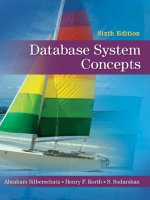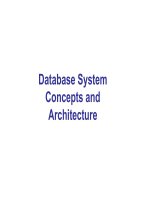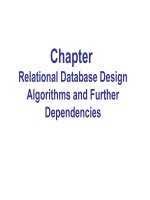chapter 1 database system concepts and architecture
Bạn đang xem bản rút gọn của tài liệu. Xem và tải ngay bản đầy đủ của tài liệu tại đây (925.55 KB, 42 trang )
Chapter 1:
Database System Concepts
and Architecture
Jan - 2014
1
Outline
File-based Approach and Database Approach
Three-Schema Architecture and Data
Independence
Database Languages
Data Models, Database Schema, Database
State
Data Management Systems Framework
Jan - 2014
2
Outline
File-based Approach and Database Approach
Three-Schema Architecture and Data
Independence
Database Languages
Data Models, Database Schema, Database
State
Data Management Systems Framework
Jan - 2014
3
File-based Approach
Data is stored in one or more separate
computer files
Data is then processed by computer
programs - applications
Jan - 2014
4
File-based Approach
Jan - 2014
5
File-based Approach
Problems/Limitations
Jan - 2014
Data Redundancy
Data Inconsistency
More details: see [2]
6
File-based Approach
Jan - 2014
7
File-based Approach
Shared File Approach
Data (files) is shared between different
applications
Data redundancy problem is alleviated.
Data inconsistency problem across different
versions of the same file is solved.
Jan - 2014
8
File-based Approach
Shared File Approach
Other problems:
Jan - 2014
Rigid data structure: If applications have to share
files, the file structure that suits one application
might not suit another.
Physical data dependency: If the structure of the
data file needs to be changed in some way, this
alteration will need to be reflected in all application
programs that use that data file.
No support of concurrency control: While a data
file is being processed by one application, the file
will not be available for other applications or for ad
hoc queries.
9
Files
Applications
Customer
Orders
Files
Customer
File
Applications
Stock
File
Order
File
Customer
Orders
Stock
File
Customer
File
Customer
Invoicing
Stock
File
Customer
Invoicing
Order
File
Order
File
Stock
File
Purchase
Orders
Stock
Control
Order
File
Jan - 2014
Purchase
Orders
Supplier
File
Supplier
File
Stock
File
Customer
File
Stock
Control
Shared file approach
10
Database Approach
Arose because:
Definition of data was embedded in application
programs, rather than being stored separately and
independently
No control over access and manipulation of data
beyond that imposed by application programs
Result:
Jan - 2014
The Database and Database Management
System (DBMS).
11
Database Approach
Jan - 2014
12
Database Approach
Data
Known facts that can be recorded and that have
implicit meaning
Information? Knowledge?
More: www.whatis.com
Database: Shared collection of logically
related data and a description of this data,
designed to meet the information needs of an
organization
Jan - 2014
13
Database Approach
System catalog (metadata) provides description of
data to enable program–data independence.
Logically related data comprises entities, attributes, and
relationships of an organization’s information.
DataBase Management System (DBMS): a generalpurpose software system that facilitates the processes of
defining, constructing, manipulating, and sharing
databases among various users and applications (or a
software system that enables users to define, create,
maintain, and control access to the database)
Jan - 2014
14
Database Approach
Data Definition Language (DDL)
Data manipulation language (DML).
Query language: retrieve (query), update (insert, delete, modify)
Controlled access to database may include:
Permits specification of data types, structures and any data
constraints to be stored in the database
All specifications are stored in the database
a security system
an integrity system
a concurrency control system
a recovery control system
a user-accessible catalog
Database System = the Database + DBMS software
Jan - 2014
15
Database Approach
Roles in the Database Environment
Database Administrator (DBA): responsible for
Database Designers: responsible for:
Jan - 2014
authorizing access to DB
coordinating & monitoring its use
acquiring software and hardware resources
security breach, poor response time
identifying the data to be stored in DB
choosing appropriate structures to represent and store this data
Application Programmers
End Users
More details: see [1,2]-chapter 1
16
Database Approach
Jan - 2014
DBMS components:
17
Database Approach
Characteristics of the Database Approach:
Self-describing nature of a database system
Insulation between programs and data, and data
abstraction
Jan - 2014
Program-data independence + Program-operation
independence = Data abstraction
A data model is a type of data abstraction
Support of multiple views of the data
Sharing of data and multi-user transaction processing
Other advantages of using the DBMS approach: see
[1]-1.6
18
Database Approach
History of database systems
First generation: Hierarchical and Network
Second generation: Relational
Third generation: Object-Relational, ObjectOriented
Brief history of database applications
Jan - 2014
see [1]-section 1.7
19
Example of Network Model
Schema
Jan - 2014
20
Example of Relational Model
Schema
Jan - 2014
21
Outline
File-based Approach and Database Approach
Three-Schema Architecture and Data
Independence
Database Languages
Data Models, Database Schema, Database
State
Data Management Systems Framework
Jan - 2014
22
Three-Schema Architecture and
Data Independence
Objectives of Three-Schema Architecture:
Jan - 2014
All users should be able to access same data
Users should not need to know physical database
storage details
DBA should be able to change database storage
structures without affecting the users’ views
Internal structure of database should be
unaffected by changes to physical aspects of
storage
DBA should be able to change conceptual
structure of database without affecting all users
23
Three-Schema Architecture and
Data Independence
Three-level architecture and data independence
Jan - 2014
24
Three-Schema Architecture and
Data Independence
External Level
Users’ view of the database
Describes that part of database that is relevant to
a particular user
Conceptual Level
Jan - 2014
Community view of the database
Describes what data is stored in database and
relationships among the data
25









